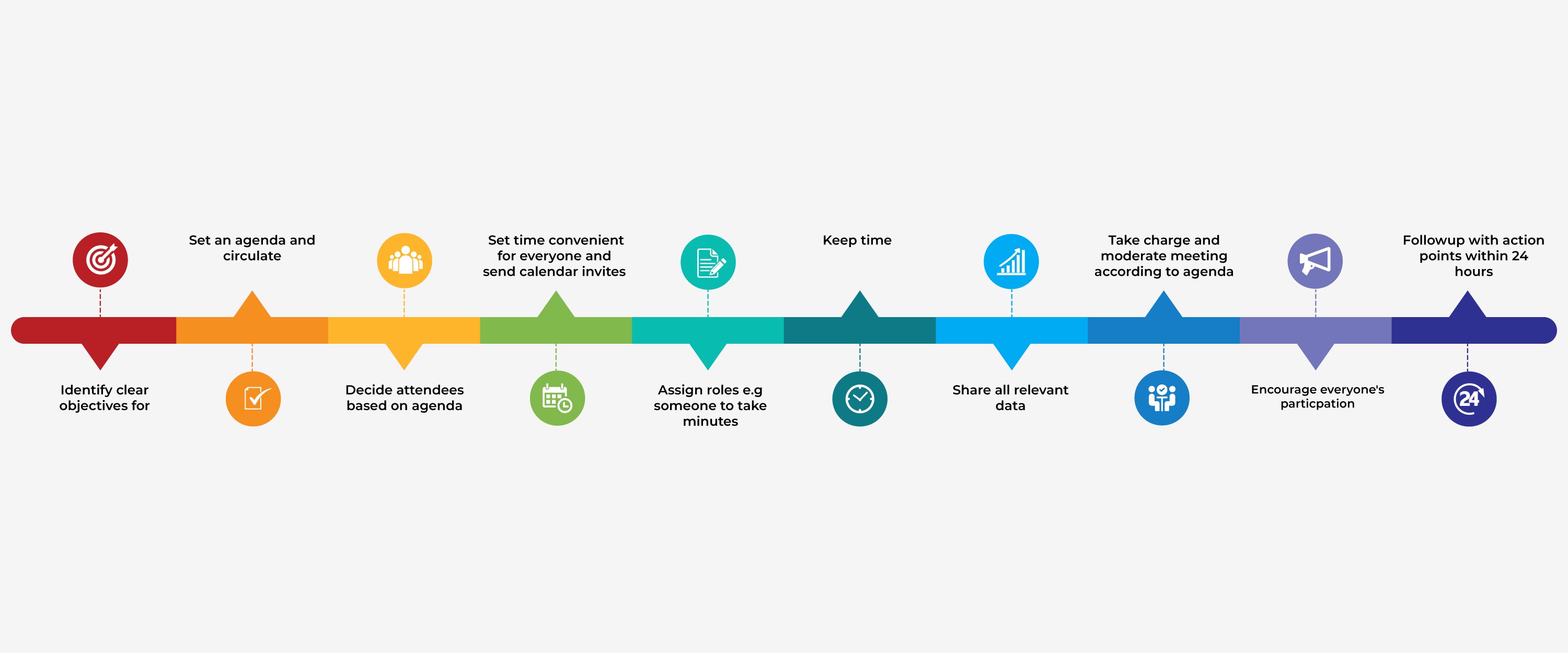We have heard about them or sat through them. Meetings that go on and on and in the end, all you remember is only what was said within the first 30 minutes of the 3-hour meeting. Meetings are a part and parcel of the world of work but, people have abused them so much over time that they have become a bore.
Most people would do without meetings. In fact, people cite meetings as the number one way of wasting time and this is evident, based on the time spent in meetings and the rate at which issues are quickly forgotten.
Take a casual glance at people in meetings. Farida will probably be on her phone the entire time, while Kiprop will probably be tapping away on his computer, while Omosh will mentally leave the room as soon as the head of the department is done talking. So, meetings go on for a whole day and at the end, no one knows exactly why they are there. Since some meetings are absolutely necessary, it then becomes important to learn what works and what doesn’t.
Table of Contents
When Are Meetings Most Productive? Short and Long Meetings Compared
When it comes to productivity, there is no one-size-fits-all answer. Some people feel most productive in the morning, while others prefer to save their energy for later in the day. The same goes for meetings – some are more productive when they are short and concise, while others benefit from a more lengthy discussion.
Here, we will explore the advantages and disadvantages of both short and long meetings, so that you can decide which type works best for your team!
Short meetings are often more effective than longer ones. They give everyone an opportunity to share their ideas and thoughts without spending too much time on any one topic or issue. This way, no one feels pressured into making decisions that might not be right for them personally (or professionally). The shorter duration also means less distraction from other tasks at hand and a more focused discussion.
However, short meetings can also be limiting. If there is a lot of ground to cover, it might not be possible to get through everything in such a short period of time. This can lead to frustration on the part of participants, and ultimately less productive discussions. Additionally, if everyone is not on the same page, a short meeting can quickly become derailed.
Longer meetings have their own set of advantages and disadvantages. On the plus side, they allow for a more in-depth discussion on specific topics, which can lead to better decisions being made. They also provide participants with an opportunity to share more information and hear from everyone involved. This helps ensure that everyone is aligned in terms of goals and objectives, which helps make meetings more productive overall.
However, longer meetings can also be draining for attendees if they are not used to this type of format. They may feel tired or bored after spending so much time on one topic (or multiple topics) without a break between them. Additionally, if the meeting does not have a specific goal or objective, it can easily go off track.

Ultimately, the best type of meeting for your team will depend on their individual needs and preferences. If you are looking for more focus and productivity, then short meetings might be the way to go. However, if you need more time to discuss things in-depth or explore new ideas, a longer meeting might be more beneficial.
Tips on managing team meetings successfully
Here are tips on how to hold effective meetings and get the message across.
Avoid meetings

Yes, holding meetings in some cases is very important but do you really have to meet to be told that the company won some award last week? If a simple email can get the job done, then there is really no need to hold a meeting. In some cases, a short walk to the concerned party’s desk is all you need to pass information or get the information you need. With the rise of chat apps that help create collaborative teams like Slack and Skype, you can even form a group where short discussions are held. In short, avoid meetings unless they are absolutely necessary.
Involve those who are absolutely necessary

There is no need for inviting all of 20 members of a department for a meeting when all you need are 3 key people to get what you need. On the other hand, if you only invite 2 people to a meeting and leave out the most important person, then that meeting just becomes a waste.
If a meeting only requires three key people from a department, then avoid calling 10 people for the meeting. So, before preparing those calendar invites, determine who the key players are and then invite them only.
Be very clear on the objective and agenda for the meeting

Before calling for a meeting, decide what items you want to be discussed. This will further help you in determining who should be invited. Most minutes are lost in trying to decide what is to be discussed in a meeting as opposed to actually having fruitful discussions. With a clear agenda and goal, you set the pace for the meeting and ensure that time is not wasted trying to find something to discuss or repeating the same items already discussed over and over.
Better still, let those who are invited know what is to be discussed beforehand. This way, they come prepared and the agenda items move along faster. If they feel that their input will not be useful, then they can assign the most qualified person for the meeting or pull out altogether. The end result is a short meeting where everyone is engaged and sticks to the greater idea.
4. Allocate time to each agenda and person

Do not give people the free will to talk until they are tired of talking. They will be tempted to start giving examples with how they had beautiful family getaway over the weekend, which gave them clarity. Set strict timelines for each agenda item and ensure that people do not take more time than allocated. This way, people will stick to the main points and the meeting will not drag on for a whole day. Once you set the precedent of starting and ending meetings on time, people will learn how to stick to the clock and the culture will spread across the organisation.
Remove comfort

Ever wondered what motivates people to sit in a meeting for an entire day? Well, one factor is a cosy chair, and a warm room; topped up with a few bittings and drinks. Everyone loves that comfort zone and once you make meetings this good, then the result is meetings set up to discuss what colour of paint would be ideal for the planned face-lift of the company instead of a simple SurveyMonkey poll to do the same.
If the meeting does not require presentations, then a simple stand up will do the trick. Most people hate standing up so when the frills are removed, people will be encouraged to stick to what is necessary and meetings, which traditionally lasted for no less than an hour will last for 15 minutes. No one wants to annoy their colleagues with endless stories while they are standing so help people think on their feet by making them stand up for meetings whenever possible.
Allocate time for issues arising

Manage how the time is spent during meetings by reducing interruptions caused by issues being raised outside the agenda items. Make some time at the end of the meeting for any other points that anyone might want to raise but insist on brief discussions. This way, there will be a smooth flow of the meeting with the most important issues taking precedence. Regular interjections waste time and this might lead to the meeting being dragged on for ages. So, create time for non-agenda items at the end of the meeting.
7. Follow-up

Once the meeting is done, send a polite email to those who were in the meeting, giving a summary of what was discussed. This way, you ensure that everyone is on the same page. Additionally, those issues that might not have been well-understood now get some clarity.
Meetings are part of the world of work. However, most meetings tend to take too much time, which leads to more time being used to discuss issues rather than to implement them. Hold effective meetings through these simple rules and you will never have a hard time convening a meeting.
Below is an infographic showing the important factors to consider when planning for meetings.






